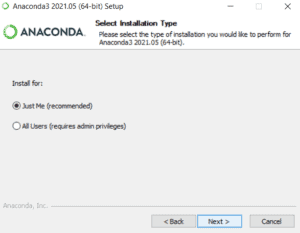

- #Anaconda prompt not in folder install#
- #Anaconda prompt not in folder full#
- #Anaconda prompt not in folder software#
- #Anaconda prompt not in folder free#
- #Anaconda prompt not in folder windows#
This makes it so that it can be called without activation or Python in a child environment can't find the necessary OpenSSL library.Ĭonda itself includes some special workarounds to add its necessary PATHĮntries. HTTP or SSL errors are common errors when the If environments are not active, libraries won't be found and there
#Anaconda prompt not in folder windows#
Instead, Windows relies on a dynamic-link library search order. The Windows library loader does not support the concept of librariesĪnd executables that know where to search for their dependencies Windows is extremely sensitive to proper activation. So on Windows, run: c:\Anaconda3\Scripts\activate base in If you receive this warning, you need to activate your environment. To activate this environment please see https : // conda. Warning : This Python interpreter is in a conda environment, but the environment has not been activated. To activate an environment: conda activate myenv When you have the environment active so it is local to a terminal session, We do not recommendĪctivation prepends to PATH. You can end up with system PATH values taking precedence over When you installįor All Users, we add it to the system PATH. When you installĪnaconda for Just Me, we add it to the user PATH. On Windows, PATH is composed of two parts, the system PATH and the To PATH, it does not call the activation scripts. To my PATH environment variable.” This is not recommended because theĪdd to PATH option appends Anaconda to PATH. Use the config API to set environment variables. These activation scripts are how packages can set arbitraryĮnvironment variables that may be necessary for their operation. The environment and running any activation scripts that the environment mayĬontain. Activation entails two primary functions: adding entries to PATH for
#Anaconda prompt not in folder software#
Make sure that the file was created from a working environment,Īnd use it on the same architecture, operating system, andĪctivating environments is essential to making the software in the environments To ensure that the packages work correctly, txtĬonda does not check architecture or dependencies when installingįrom a spec file.
#Anaconda prompt not in folder install#
To create this spec list as a file in the current workingĬonda install - name myenv - file spec - file.
#Anaconda prompt not in folder free#
com / pkgs / free / osx - 64 / readline - 6.2 - 2. com / pkgs / free / osx - 64 / python - 3.5.2 - 0. com / pkgs / free / osx - 64 / openssl - 1.0.2 h - 1.

# This file may be used to create an environment using: # $ conda create -name -file # platform: osx-64 https : // repo.

Makes it so that your command prompt is now prefixed with the activeĮnvironment’s absolute path rather than the environment’s name.Īfter activating an environment using its prefix, your prompt will Specifying an install path when creating your conda environments
#Anaconda prompt not in folder full#
You’ll generally need to pass the -prefix flag along with theĮnvironment’s full path to find the environment. There are a few things to be aware of when placing conda environmentsĬonda can no longer find your environment with the -name flag. If you keep all of your environments in your envsįolder, you’ll have to give each environment a different name. Subdirectory is that you can then use the same name for all yourĮnvironments. The required software, is contained in a single project directory.Īn additional benefit of creating your project’s environment inside a It makes your project more self-contained as everything, including Your Jupyter notebook should now start in your desired folder, if not bear with me you can try this second method.It makes it easy to tell if your project uses an isolated environmentīy including the environment as a subdirectory. Make sure to remove the hash mark # before and replace the line by by c.NotebookApp.notebook_dir = 'Disk:\\your\\desired\\working\\directory' T hen o p en thi s file in any Editor and search for the following line: “c.NotebookApp.notebook_dir” This will generate a file to your user default directory: C:\Users\username\.jupyter\jupyter_notebook_config.py Open the windows powershell prompt or the powershell Anaconda prompt and type the following: jupyter notebook -generate-config I have two laptops with Anaconda installed on both and I had some issues to find a working solution to configure the start in folder of Jupyther so I though it’d be a good idea to post the two solutions that worked for me.


 0 kommentar(er)
0 kommentar(er)
